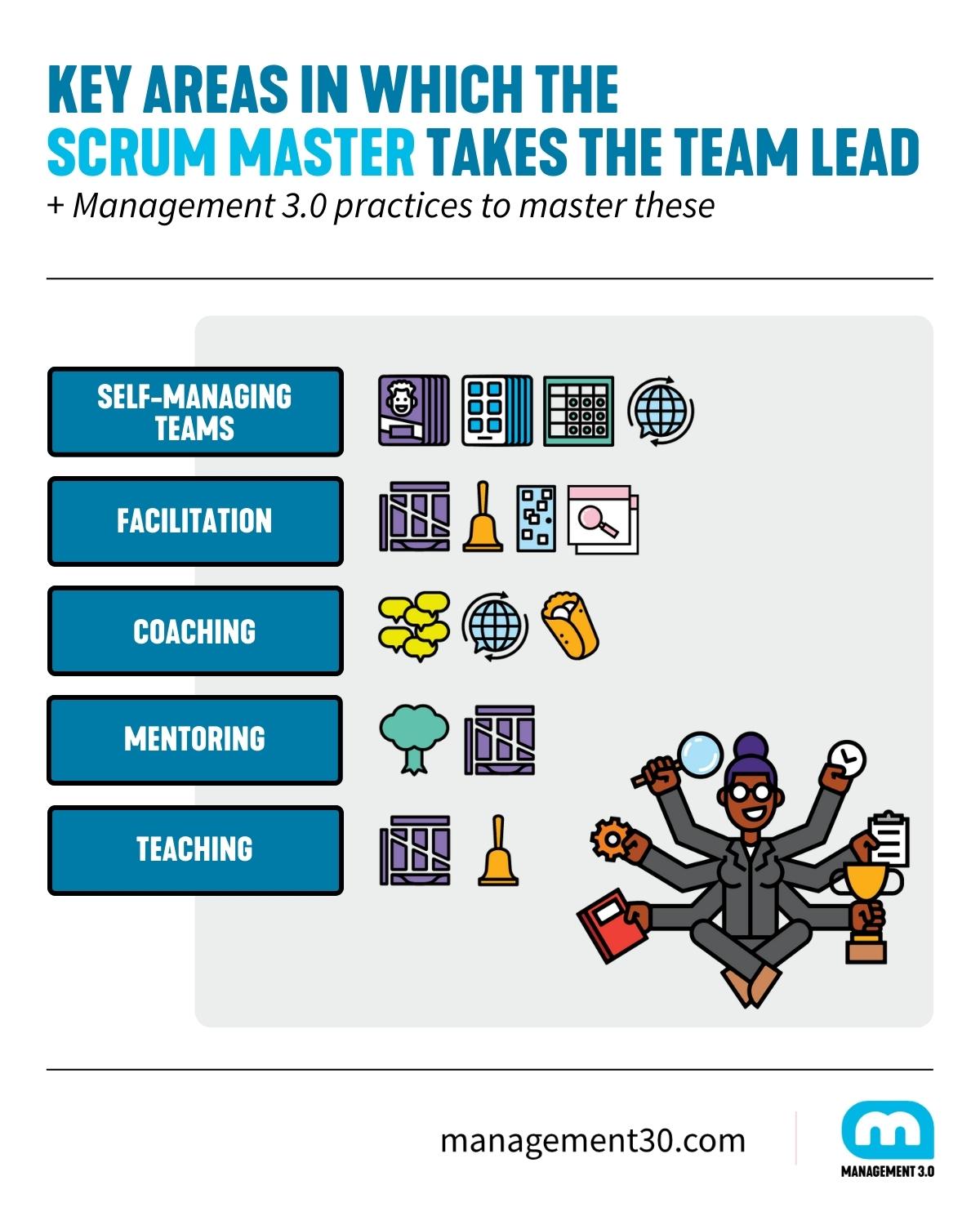Juan Mello, Management 3.0 Facilitator and seasoned Scrum Master tries to find an answer.
My career as Scrum Master started in 2014.
During these eight incredible years, and after working and collaborating with more than 30 Scrum Masters, alongside promoting different agile communities, this question (which seems pretty simple and obvious at first sight) is still one of the most unclear and controversial ones: Is the Scrum Master a leader of the team? Similarly, the Scrum Master can be heard asking: Am I supposed to lead the team, or just ensure events happen?
Before jumping to an answer, we need to understand what a Scrum Master does and what their main competencies are.
In this article, I will try to give my humble opinion based on my experiences and varied learnings, which I hope can help you at some point in case you have similar questions or concerns.
What is a Scrum Master?
The Scrum Master is one of the three accountabilities within a Scrum Team.
When we often hear concepts like “Servant leader” or “Servant leadership,” we quickly associate it with the role/accountability of the Scrum Master.
The concept of “Servant-leader” was introduced by Robert Greenleaf in his essay The Servant as a Leader in 1970.
What are the Scrum Master’s Responsibilities?
As per the official Scrum Guide, the Scrum Master is accountable for establishing Scrum as defined in the Scrum Guide. This is done by helping everyone understand Scrum theory and practice, both within the Scrum Team and the organization.
The Scrum Master is held accountable for the Scrum Team’s effectiveness. They do this by enabling the Scrum Team to improve its practices within the Scrum framework.
Why is the Scrum Master Role Sometimes Misunderstood?
Over the last few years, more and more companies have adopted Agile practices and implemented Scrum in particular. However, with this explosion in popularity, Scrum has been understood poorly, and the role of the Scrum Master is not an exception.
Sadly, in many organizations, the role is understood purely as a facilitator, just to schedule meetings, create reports, take meeting notes, control timeboxes and facilitate fun retrospectives. These perceptions were common, experienced by myself and many colleagues.

In response, when Scrum.org released the latest version of the Official Scrum Guide in 2020, the term “Servant-leader for the Scrum Team” was changed to “True leader who serves the Scrum Team.”
This was indeed a necessary change. My interpretation reflects the true essence of the Scrum Master: someone who coaches a team, develops its people and leads the agile transformation.
Scrum Masters in the Leadership Role
One of my favorite Management 3.0 quotes is deeply related to what a Scrum Master – a true leader – is and does: Manage the System, not the People.
As Scrum Masters, we do not manage the team and the people; we create an environment that helps the team achieve results and outcomes.
How? On the one hand, implementing frameworks, helping reduce waste (ensuring blockers are resolved as quickly as possible), and developing and leading people by supporting them and recognizing everyone’s individuality.
On the other hand, as Scrum Masters and true team leaders, it is vital to develop people and teams through essential competencies like facilitation, coaching, mentoring, and training. Additionally, understanding different leadership styles is key to leading a team and helping them incrementally introduce self-management.
Management 3.0 provides us with solid tools that help in these areas, as I explain below.
Key Areas in which the Scrum Master takes the Team Lead – and how Management 3.0 can Help you Master These
According to Scrum.org and their Professional Scrum Competency, there are certain focus areas through which to develop people and teams. Let’s look into how Scrum Masters can achieve these with the help of Management 3.0:

Self-Managing Teams
“A fundamental foundational element to Scrum; cross-functional, self-managing, and empowered teams are the engine to delivering value.”
Scrum Masters who want to introduce more self-management to their team might try these Management 3.0 practices:
Change Management Game: how the team will face changes they are involved in and how they will self-manage when facing these changes.
Delegation Poker & Delegation Board: agree with the team on how tasks and responsibilities will be delegated, in other words, how to empower them.
Team Decision Matrix: works very well with the Delegation practice. Empowerment and delegation are great, but it is also essential to understand how the team will make decisions, how they will organize internally, and how they will self-organize.
Team Competency Matrix: find the competency gaps to work on to achieve the team’s goals and gradually become a cross-functional team.
Facilitation
“Facilitation is a set of practices that help support the collaboration, communication, and creativity of teams and individuals.”
Facilitation is a significant part of the Scrum Master’s job. Here is how Management 3.0 practices can help:
Yay! Questions: facilitates a transparent space to talk about what the team has learned and what went well.
Celebration Grid: generates a conversation about the different experiments done and what the team learned about them.
Moving Motivators: creates a safe and fun space to understand individual and team intrinsic motivators.
Happiness Door: provides another tool for the team to generate engaged feedback and express their opinions and points of view, which is very useful after facilitating a team meeting.
Coaching
Scrum Masters are often coaches, too. According to Scrum.org, “The ability to unlock new ways of thinking is important for any agile practitioner who aims to enable sustaining change and transformation within teams and organizations.”
If you, as a Scrum Master, would like to improve your coaching skills to serve your team better and take on a leadership role, you could experiment with these Management 3.0 practices:
Improvement Dialog: one-on-ones and pair working are two examples of people helping employees and colleagues learn how to do better work.
Change Management Game: questions that help to coach the team to reflect on how they will face the changes they are involved in.
Feedback Wrap: creates a healthy culture through constructive feedback and enables us to coach people and teams by asking powerful questions and unlocking new ways of thinking and acting.
Also read: Living the coach approach.
Mentoring
Besides coaching, Scrum Masters also embody the mentor role in their team: “There are many ways to support people in their personal growth and improvement in their work. Mentoring is particularly useful because it brings forward personal stories and experiences that aid another person in uncovering their own way to accomplish something”.
Management 3.0 practices that can help us here include:
Value Stories: mentoring the team by sharing our personal stories and experiences.
Celebration Grid: understanding how the team’s experiment went and what the team learned. Mentor them by sharing previous experiences to think about new experiments.
Teaching
Lastly, Scrum Masters are also teachers: “The ability to inspire others to learn and share information in an effective, repeatable, and efficient manner is a key aspect to any agile practitioner’s skills.”
Management 3.0 practices that can help us here:
Yay! Questions: allows us to understand what things are not working as expected and detect new training needs in the team.
Celebration Grid: this practice is very connected with the ‘Yay! Questions.’ When teams learn from failure, we can detect and elaborate on different topics that teams need training on.
As a final note, I think that we, as Scrum Masters, are the main ones responsible for educating our organizations about the role and why we should be considered leaders for our teams.
In my experience, sometimes it is best to show tangible actions and results with our teams instead of explaining and trying to convince our audience. For that, Management 3.0 can be extremely useful and beneficial!
Header Photo by Daniel K Cheung on Unsplash













From the responsibilities carried out by the Scrum Master Certification as expressed in the Scrum Guide it is established that, the Scrum Master with the responsibilities rendered he stands as the leader of the organization.
Thanks Tenjei for your inputs!